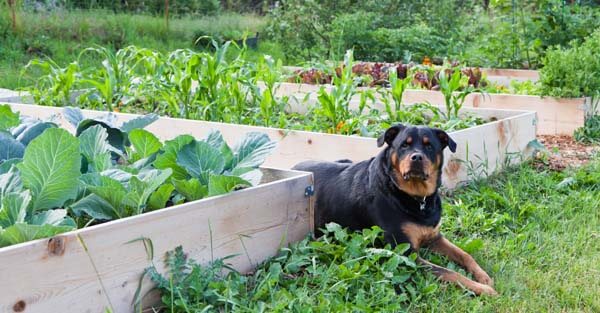
You love your dog. You love your garden. Sometimes, though, your dog and garden just don’t get along, and it is harder to feel the love. The dog follows its instincts and digs, pulls up plants, romps over delicate specimens, and relieves himself in the wrong places. You follow your instincts and get frustrated.
What can you do?
As with all things related to gardening, a little planning can prevent a lot of mayhem. Make a few adjustments to accommodate dog and animal priorities, and you can transform the garden into a place where both the resident gardener and the resident canine/s can feel comfortable.
Paths for Dogs
Create garden paths and raised bed borders to keep straying humans and dogs out of garden beds and borders. Paved walkways are the best way to prevent muddy paws, but fine gravel or mulch will also work. Avoid using cocoa bean mulch along the paths or in beds because it is toxic to dogs, and they like to eat it.
Training

Famed dog trainer, Barbara Woodhouse, famously said, “Dogs aren’t born knowing what or what not to do; they only learn like children.” Invest in proper training for your four-legged “child” so that the two of you can work together to set boundaries—literally and figuratively—for garden behavior. Training works best when you start on a puppy, but even older dogs can benefit, especially from a skilled trainer.
Training does not have to be expensive. A wide array of available books, videos, and apps can guide you through gentle, effective ways of training your dog. No matter what method you choose, the cost of training beats the trouble and expense of repairing your landscape when your furry friend misbehaves.
Planting for Dogs

Use tough plants along paths and other canine traffic areas and plant densely, because bare earth invites canine curiosity, mischief, and digging. Enrich the soil every time you plant by using a quality amendment like Fafard® Garden Manure Blend to encourage thick, leafy growth
Ornamental grasses, compact shrubs, and even sturdy, clump-forming perennials, like big-root geranium (Geranium macrorrhizum), can withstand the occasional trampling or exuberant full-body roll and survive intact. Low-boundary fencing may also help separate pets from plants.
Avoid planting species and varieties with sharp prickles or spines, and keep toxic plants confined to areas that are off-limits to your dog. For a list of toxic indoor and outdoor plants, go to the ASPCA website on toxic plants (click here to view) or read our article about the 12 Most Poisonous Plants to Avoid for Kids and Pets.
Dedicated Relief
Dogs also need places to relieve themselves. If you don’t set aside those dedicated spaces and train the dog to use them, dog waste will harm your lawn and garden. Garden sculptures and other formative yard decor are often attractive to dogs for this purpose. Better they wee on something structural than your plants. Encourage your dogs to mark the right garden areas, and they will return to those spots. Also, keep a pooper scooper handy to keep the lawn clean.
Dog Distractions

A bored canine is an unhappy canine. Keep some favorite dog toys in your garden basket or cart and use them to entertain the dog while you plant, weed, and water. Taking a moment to give your dog a chew toy or throw a ball is much better than watching pup munch the stems of your prize coneflowers and daisies.
Exercise

Humans get flabby and unhappy without sufficient exercise, and dogs are no different. Walk your dog at least forty-five minutes every day, or hire someone else to do so when time is at a premium. Space permitting; install an enclosed dog run in a corner of your yard, with a latched gate and appropriate shelter for dogs that stay outside periods. A dog that gets regular exercise is less likely to tear up the iris bed or uproot the tomatoes.
One of the most celebrated gardeners and dog lovers was the late English plantsman, Christopher Lloyd, who rarely set foot in his garden at Great Dixter without his faithful dachshunds. Less famous gardeners agree that canine companionship is good for the psyche and may also deter plant predators like rabbits, groundhogs, and deer. Even if your dog only wags his tail at rabbits and groundhogs, if he is happy, chances are you will be happy, and the garden will be a better place all the way around.

